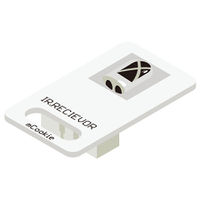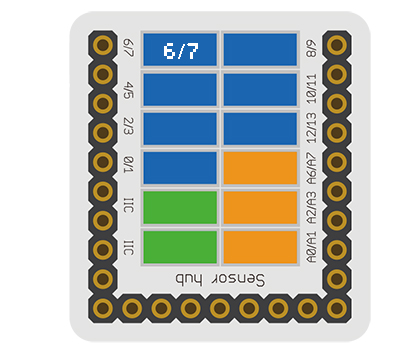|
The product number of Sensor-IR-receiver is: MSDI22
Sensor-IR-receiver is an infrared receiving sensor.
Sensor-IR-Receiver contains a semiconductor device, which can turn the infrared light signal into electrical signal. Its core part is a PN junction with special material. Compared with the ordinary diode, it adopts great change in structure with a larger infrared receiving area, which makes the current increase accordingly.
Introduction of Sensor Pins
|
|
- Pins of the sensor:
- PIN1: GND
- PIN2: VCC
- General signal pins:
- PIN3(IO1): digital/analog signal
- PIN4(IO2): NC(null)
- Special signal pins:
- If it is IIC: IO1/IO2 are respectively SDA/SCL.
- If it is soft serial port: IO1/IO2 are respectively tx/rx.
|
Microduino sensor can communicate with core module through the connection with Microduino-Module Sensor Hub.
|
IR Receiver
| General Pin Out
|
Sensor / Trinket's Pin Out
|
| PIN1 (GND)
|
GND
|
| PIN2 (VCC)
|
VCC
|
| PIN3 (SIGNAL-A)
|
Digital Input
|
| PIN4 (SIGNAL-B)
|
Not Connected
|
- General Pin Out is the standard pin out of a Sensor / Trinket connector.
- Sensor / Trinket's Pin Out is this specific Sensor / Trinket's wiring in relation to the General Pin Out.
- SIGNAL-A / SIGNAL-B are signals that could be digital input, digital output, analog input or analog output. Or special signals such as serial communication (SoftwareSerial, IIC (I2C), etc) or other special signals.
- Not Connected refers to the Pin not being used for this particular Sensor / Trinket.
- Read more about the hub module.
Features
- Pulse type;
- Long receiving distance and strong anti-interference ability;
- With small size which is easy to install
Specification
- Voltage
- Electronic specification
- Working current: 15uA
- Working temperature: -20~85℃
- Size
- Size of the board: 23.5mm*13mm
- 1.27mm-spacing 4Pin interface connected with sensorhub
- The CAD drawing of the sensor: File:Sensor CAD.zip
- Technical parameters
- The wave length is between 0.76~1.5μm
- Connection
- This sensor can be connected to the following interfaces of the core: D2~D13,A0~A7
Document
Development
Program Download
Programming
Hardware Setup
Result
- After download, open the serial monitor.
- Send IR signal to the IR receiver with IR remote control, and you can see the LED on the IR Receiver flash once, representing that the IR Receiver has received the IR signal, and the decoded data will be printed out in the serial monitor at the same time.
Application
It can be used in infrared remote control, which is able to be matched with all kinds of infrared remote controller. You need to make sure the infrared signal type and protocol format before using.
History
Pictures
|


